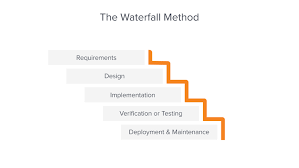Exploring the Evolution of Waterfall Development in Software Engineering
The Waterfall Development Model
The waterfall model is a traditional approach to software development that follows a linear and sequential process. In this model, each phase of the development cycle must be completed before moving on to the next phase, resembling a waterfall cascading down in steps.
Phases of the Waterfall Model
The waterfall model typically consists of the following phases:
- Requirements Gathering: In this initial phase, project requirements are gathered and documented.
- System Design: The system design phase involves creating a high-level design of the software based on the gathered requirements.
- Implementation: Developers start coding based on the design specifications in this phase.
- Testing: Once the implementation is complete, testing is carried out to identify and fix any defects.
- Deployment: The final product is deployed to users after successful testing.
- Maintenance: Post-deployment, maintenance activities such as updates and bug fixes are performed as needed.
Advantages of the Waterfall Model
The waterfall model offers several advantages, including:
- Clean and simple approach
- Easy to understand and manage due to its linear structure
- Well-suited for projects with stable requirements
Disadvantages of the Waterfall Model
However, the waterfall model also has its limitations, such as:
- Rigidity in accommodating changes once a phase is completed
- Risk of customer dissatisfaction if requirements change during development
- Limited scope for client feedback until later stages of development
In Conclusion
The waterfall development model remains a popular choice for projects with well-defined requirements and where changes are expected to be minimal. While it may not be suitable for all types of projects, understanding its principles can provide valuable insights into software development processes.
5 Essential Tips for Effective Waterfall Development: Ensuring Success from Planning to Execution
- Clearly define requirements upfront to avoid scope creep.
- Break down the project into distinct phases for better control and management.
- Ensure thorough testing at each stage to catch issues early on.
- Document extensively to maintain clarity and facilitate future maintenance.
- Seek feedback from stakeholders at key milestones to ensure alignment with expectations.
Clearly define requirements upfront to avoid scope creep.
To prevent scope creep in waterfall development, it is crucial to clearly define requirements upfront. By establishing a detailed and comprehensive set of project requirements at the beginning of the development cycle, teams can minimize the risk of unexpected changes or additions later on. This proactive approach helps maintain project focus, budget adherence, and timeline consistency, ultimately leading to a more successful and efficient software development process within the waterfall model.
Break down the project into distinct phases for better control and management.
Breaking down the project into distinct phases is a key tip in the waterfall development model as it allows for better control and management of the software development process. By clearly defining and separating each phase, teams can focus on one aspect at a time, ensuring thorough completion before moving on to the next stage. This approach enhances visibility into the project progress, facilitates tracking of milestones, and enables effective resource allocation. Ultimately, breaking down the project into distinct phases promotes systematic and organized development, leading to improved quality and successful project delivery.
Ensure thorough testing at each stage to catch issues early on.
Ensuring thorough testing at each stage of the waterfall development process is crucial to catch issues early on and mitigate potential risks. By conducting comprehensive testing throughout the project lifecycle, developers can identify and address any defects or inconsistencies promptly, leading to a more robust and reliable final product. Early detection of issues not only helps in maintaining project timelines but also contributes to overall cost-effectiveness by avoiding costly rework later in the development cycle. Prioritizing rigorous testing at every phase of the waterfall model enhances the quality of the software and increases customer satisfaction by delivering a polished end product.
Document extensively to maintain clarity and facilitate future maintenance.
Documenting extensively throughout the waterfall development process is crucial to maintaining clarity and facilitating future maintenance. Detailed documentation helps ensure that all project requirements, design decisions, code implementations, and testing procedures are well-documented and easily accessible to team members and stakeholders. This not only aids in understanding the project’s progress but also streamlines future maintenance activities by providing a clear reference point for making modifications or troubleshooting issues. Effective documentation serves as a valuable asset in ensuring the long-term success and sustainability of software projects developed using the waterfall model.
Seek feedback from stakeholders at key milestones to ensure alignment with expectations.
Seeking feedback from stakeholders at key milestones in the waterfall development process is crucial to ensure alignment with expectations. By involving stakeholders early and regularly throughout the project, developers can validate that the work meets the desired requirements and make necessary adjustments before progressing further. This proactive approach not only helps in identifying potential issues sooner but also fosters collaboration and transparency, ultimately leading to a successful project outcome that meets stakeholder needs and expectations.



